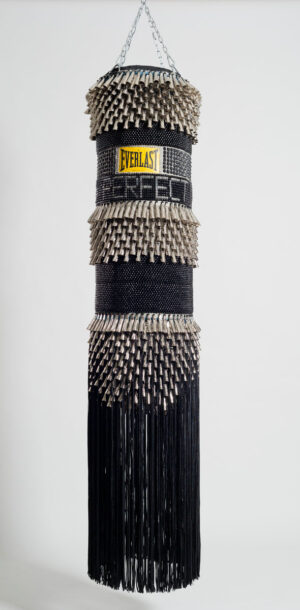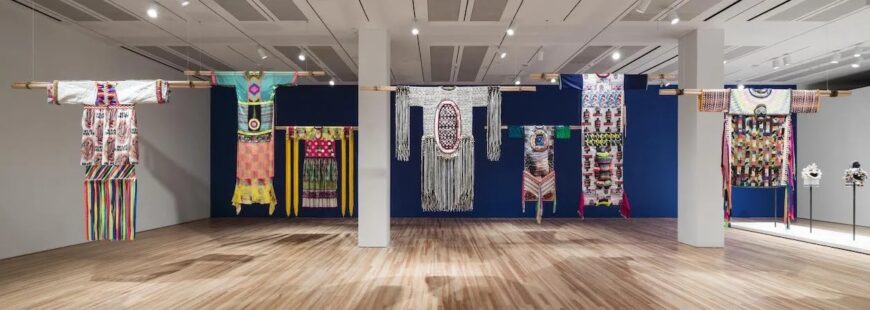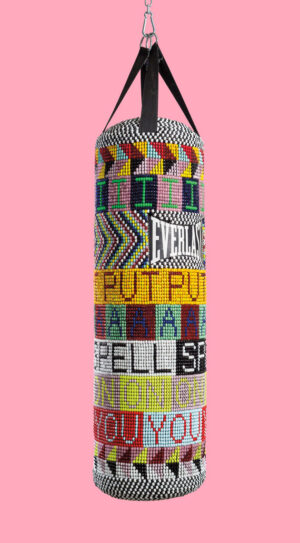
Jeffrey Gibson, I’m Not Perfect, 2014, found canvas punching bag, repurposed wool army blanket, glass beads, tin jingles, nylon fringe, artificial sinew, acrylic paint, 191.8 x 40.6 x 40.6 cm (photo: Marc Straus Gallery) © Jeffrey Gibson Studio
A punching-bag hangs from the ceiling, embellished with beads, tassels, and jingles. Frills of jingles encircle the shaft in three bands, around the top, middle, and bottom. The bands sharply contrast the two segments in between that are tightly woven with beads. The upper segment has two texts: “Everlast,” the brand of the bag, is written in black on yellow ground; and below it, the phrase “I’M NOT PERFECT” is woven with black and gray beads, combined with leather. The three bands of jingles and the long black nylon tassels attached to the lowest row look like elaborate skirts. The object is one of a series of about fifty such altered punching-bags produced by Jeffrey Gibson. The series marks a crucial point in Gibson’s creative enterprise.
Simultaneously subversive and empowering
An American artist of Mississippi Choctaw/Cherokee descent based in Hudson, New York, Jeffrey Gibson (who was born in 1972) was trained at the School of the Art Institute of Chicago and London’s Royal College of Art. He uses a range of objects and materials from North America’s Indigenous cultures in his work, such as textiles, bark, beads, leather, gourds, bells, jingles, and studs. For an audience unfamiliar with the cultural nuances of these traditional artifacts and materials, hybrid objects made with them can sometimes be regarded as quaint relics of marginalized communities, a trend long popularized by the market for tourists. The simultaneously subversive and empowering role of Gibson’s art, however, can be better grasped through an understanding of its specific context and conceptual purpose, which decisively distinguishes it from collectible curios.
Gibson’s family moved frequently during his younger years because of his father’s job. His early cross-cultural experience, especially from living in Germany for several years, made Gibson aware of his own marginalization on two fronts: a queer man of Indigenous descent, he saw himself as peripheral to the mythologies of both nationality and sexuality in America. Early in his career, Gibson claims, his work failed to adequately articulate that everything personal is connected—however obliquely—to larger cultural and political issues. Frustrated and on the verge of giving up on his creative pursuits around 2010, he engaged in a fresh effort to critically examine aspects of American Native traditions that radically changed his work.
Approaching the histories of Indigenous cultures through the lens of colonialism, Gibson appropriates materials connected to ethnic customs and rituals to produce work that presents those cultures as dynamic and resilient fronts of resistance to oppression. His close attention to powwow is a case in point. A cross-ethnic social gathering and a modern response to colonialism, powwow has been a crucial agent in shaping the ideas and concepts central to Gibson’s work.

View of “Jeffrey Gibson: This Is the Day” at the Blanton Museum of Art, The University of Texas at Austin (2019), photo from an interview with the artist
For instance, incorporating materials and artifacts from multiple Indigenous sources used in powwow events, he designs tunics with textile patterns, decked with ritual objects. The garments, symbolic of mythical powers, are often used by him in live performances that hinge on notions of empowerment. The beads, jingles, and tassels used in I’m not Perfect are also notable items borrowed from powwow costumes that are used to physically alter the punching-bag and give it a fresh identity. The artist’s painting practice, too, has changed along this line of inquiry. Replacing canvas with traditional drums constructed in his studio, he paints abstract patterns on them drawn from Native fabrics. [1]
Indigenous Futurism
Gibson’s revisitation of Native histories in I’m not Perfect can be understood through the lens of Indigenous Futurism, a movement in Native cultural practices that builds on both traditional modes of representation and popular culture to generate strong statements about Native identity and empowerment. Committed artists combine motifs and characters from comics, games, and science fiction with Indigenous artifacts, oral histories, and rituals to address issues of colonialism, imperialism, and genocide from the past, and discrimination, exclusion, and marginalization of the present. In short, they employ a diverse array of narratives and objects via hybrid strategies to produce self-representations that not only shed light on various facets of contemporary Indigenous identity, but also assert the future existence of those identities. Much of Jeffrey Gibson’s current work prominently intersects with the fundamental premise of this movement.
The punching bag
Following his therapist’s suggestion in 2005, Gibson worked with a personal trainer who advised him to use punching-bags to vent his anger and frustration. The cathartic ritual of unleashing his emotions on the familiar gym accessory made him realize a disconnect between mind and body and led him to reinvent the punching-bag around 2012.

Jeffrey Gibson, I PUT A SPELL ON YOU, 2015, re-purposed punching bag, glass beads, artificial sinew, and steel, 101.6 x 35.6 x 35.6 cm (Nasher Museum of Art at Duke University, Durham) © Jeffrey Gibson Studio, photo by Peter Paul Geoffrion
The artifacts used to adorn the bags collectively symbolize Indigenous identities and pride in the face of pressure from dominant cultures. I’m not Perfect is one of the powerful examples from the early phase of the project. In other works from this series, phrases like BELIEVE BELIEVE, PEOPLE LIKE US, A VERY FUNNY DEATH, and I PUT A SPELL ON YOU, woven into the surfaces, appear as fragments of larger narratives that resist any finality. Each bag emerges with a distinct identity of its own while also playing with multiple facets of identity. The beadwork follows specific textile patterns; the arrangement of jingles and other artifacts are equally specific; and most importantly, each text is also the title of a piece.
Gibson often selects phrases and excerpts from popular songs, poetry, and radical writing. The title I’m Not Perfect is borrowed from the song “I’m Not Perfect (But I’m Perfect for You),” performed by Grace Jones in a music video in 1986, wearing a twenty-five-foot-long skirt designed by Keith Haring. The use of leather and nylon is a tribute to Jones who boldly confronted conventional gender hierarchy in this romantic anthem. “Had we met at a different time we’d be perfect for each other,” Jones sang. “Now we’re spending all our time, in this world come together/My heart is aching, from all the love you’re giving/We’re not faking, is this the life we’re living?.”
The issue of gender ambiguity is evident in this specific work, as the traditionally masculine association of the punching-bags is challenged by the impression of skirts made with jingles and tassels. What is more, Gibson is not inclined to hide the bag’s identity as manufactured merchandise. Instead, he, prominently frames the brand—Everlast—with beads, leaving it clearly visible at the center. His interest in the role of global economics behind the materials of his art production extends to the jingles we see on three sections of I’m Not Perfect. Though traditionally made of rolled tin lids from tobacco containers, the conical object so essential to Indigenous ritual garments is now manufactured in Taiwan exclusively for powwow performers, especially for Anishinaabe dance outfits. With an urgency to frame Native identities in a larger historical context, Gibson uses jingles to actively recognize the global market that connects a foreign manufacturer to traditional cultural representations.
The bags, Gibson believes, do not represent specific individuals. Rather, hanging from the gallery ceiling as they do in a gym, they stand for unjust social and cultural realities in and outside the art world. The connotation of physical aggression conventionally associated with the objects, the artist notes, is diffused by the changes made to them. While a punching-bag is meant to remain neutral when absorbing blows from a boxer, garbed in dazzling accessories, here it actively “talks back.” As works of art, not only are they metaphors for the artist’s negotiations with his fury of his own cultural and sexual marginalization in the nation’s history, replacing that rage with critical thinking, but they are also reminders of the American history of violence against Indigenous peoples as much as the violence punctuating American history. In short, this is where white and Native histories intersect. In Gibson’s self-critique, the urgency and anxiety of the bags produced initially has eventually given way to a feeling of composure that suggests more thoughtful articulation of ideas.
Jeffrey Gibson’s collaborations with Indigenous American performative traditions and visual cultures to build a new space for his art demonstrate his commitment to making material and process meaningful in his work. The series of punching-bags also demonstrate how repeated use of specific materials can enrich their symbolic potential in the artist’s revisitation of the history of Modernism from an Indigenous Futurist perspective.


